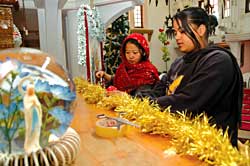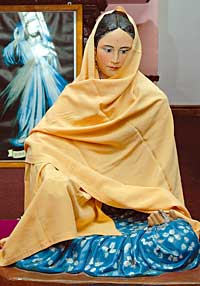 From the remote corners of Banke, Kailali, Dhangadi to the streets of Thamel, Nepali Christians are busy preparing to celebrate Christmas, their Dasain. Some Hindus and Buddhists as well will join in festivities on the big day.
From the remote corners of Banke, Kailali, Dhangadi to the streets of Thamel, Nepali Christians are busy preparing to celebrate Christmas, their Dasain. Some Hindus and Buddhists as well will join in festivities on the big day. Christmas is done in Nepali style. In the nativity scene, Baby Jesus is dressed up in a bhoto inside a doko, the Three Magis are decked up in daura suruwal. During the weekend prayer sessions, everyone takes off their shoes, squats on the floor and prays in Nepali. Even "praise the Messiah" is recited as "jai mahasi".
The New Testament was first translated into Nepali in 1821 by William Carey and is now being translated further into 12 indigenous languages. "Nothing is foreign about Christianity anymore," says church-goer Sujata Rai from Jawalakhel. "We are all one big family of Christians."
Christians have earned a positive reputation for involvement in social, health and education sectors, reaching out to the backward, poverty stricken and illiterate Nepalis in remote areas.
Among the best-known are the Jesuits who were one of the first to arrive after 1951 and they established themselves in the country by starting the boarding school, St Xaviers in Jawalakhel and Godavari. They were followed by the United Mission to Nepal (UMN), a collaborative body of several global missionaries. It made its own mark by establishing some of the best public and community hospitals, launching literacy programs, agriculture development activities and so on. It also became one of the first international NGOs to pioneer development work in Nepal. Today, it is the second-largest employer in Nepal after the government with the largest number of expatriate and Nepali staff working in UMN's projects around the country.
Other Christian charities like Caritas, International Fellowship (INF) and Nepal Leprosy Trust (NLT) have also been doing exemplary work in health and education-epsecially to reach marginalised communities who fall between the cracks. NLT is the only organisation that operates the leprosy services centre in southeast Nepal, that has the highest prevalence of leprosy. Over 20 percent of hospitals and clinics in Nepal are run by Christian charities.
The numbers of Christians in the country is growing. With less than 30 Christians in late 1950s, the number of believers increased to 200,000 in 1990 and now is estimated at one million, making up nearly four percent of the population and one of the fastest growing in the world. There are churches now in almost all the 75 districts of Nepal.
Among Christians, the Catholics have been working towards Nepalising Christianity. "Our religious differences do not affect our culture," explains Binod Gurung, president of Nepali Catholic Samaj. "We were brought up as Nepalis and have a close affinity with Hindu and Buddhist friends and we often celebrate each other's festivals."
Christianity in Nepal
 The first Christian missionaries came to Nepal over the Himalaya from Tibet more than 250 years ago. They were Tyrolean Capuchin monks and wrote in their chronicles how Kathmandu Valley was the dirtiest place they had every visited.
The first Christian missionaries came to Nepal over the Himalaya from Tibet more than 250 years ago. They were Tyrolean Capuchin monks and wrote in their chronicles how Kathmandu Valley was the dirtiest place they had every visited. They called on the Malla kings of the Valley and presented the King of Patan with a telescope. For decades after that as the Gorkha conquest began, Nepal was closed to outsiders, especially beef-eating Europeans.
But by the early 18th century, more missionaries came in from British India and their first group of local converts were from the Newar community. However, Christianity did not spread much after King Prithbi Narayan Shah came to power who saw the religion as a threat to national security and suspected Christians of being British spies. European missionaries and newly-converted Newar Christians were asked to leave the country. King Prithbi Narayan also strictly banned the conversion of Hindus into Christianity.
There is still a lingering distrust of Christians as proselytisers among Kathmandu's officialdom. Even after Nepal opened its doors to the outside world in 1950 and Christian missionaries poured in they were under strict surveillance which still did not allow conversion. The law carried a sentence of three years for the preacher, one year for the convert and six months for the baptiser. Many were persecuted during the 1980s.
During the Panchayat regime, 300 pastors were jailed for proselytising. Many were subject to police brutality and there are records of atleast one missionary having been killed. Church-goers had to keep their religious identity a secret and missionaries were effectively underground.
After the People's Movement of 1990, the new constitution granted religious freedom. When the Nepali Congress (NC) came to power it instituted democratic reforms, including freedom to practice any religion. The government introduced a law that allowed freedom of religious practice. Today, voluntary conversion from one religion to another is legal. Only forced conversion is considered illegal. With more tolerant laws and policies in place, Nepali Christians today feel very much at home. "Nepalis are a tolerant community and we no longer have any fears unlike during the Panchayat days," says Silas Bogati, parish priest from Assumption Church.


